TORONTO (Feb. 2) — They are, without question, the most–coveted items in my large collection of sports memorabilia. Having lived here in Toronto all my life (I turn 61 on Monday) — watching the Leafs as a fan and reporter for more than half–a–century — the EXPORT Maple Leaf Gardens wall calendars rekindle countless memories. Before I knew anything about collecting, I would stare wistfully at these colorful, 25½ x 16½–inch items in the barbershop at Bathurst Manor Plaza, around the corner from where I grew up, prior to getting a haircut. Once I chose to collect hockey memorabilia, they became essential acquisitions.
I am fortunate to have 15–such calendars, dating from 1956–57 to 1974–75. Those from the 1960’s are the most–valuable and sentimental, as the Maple Leafs won four Stanley Cup titles in that decade. I have the calendars from 1964–65, 1966–67 (the most–recent Toronto championship), 1967–68 (the first year of expansion), 1968–69 and 1969–70. Then, the final five that were issued: 1970–71 to 1974–75. Each item featured a color photo of the Leafs team from the previous year; the defending Stanley Cup champion; the Stanley Cup finalist; the previous year’s All–Star teams and trophy winners; team–photos of champions from the other professional hockey leagues at the time (American, Central, Western) and the Memorial Cup (Junior ‘A’) titlist. Color photography was far–less–common than it is today, as black–and–white images filled newspapers and magazines, As such, the calendar offerings were both novel and spectacular.
I’m happy to share with you the following images from my collection of Maple Leaf Gardens calendars:
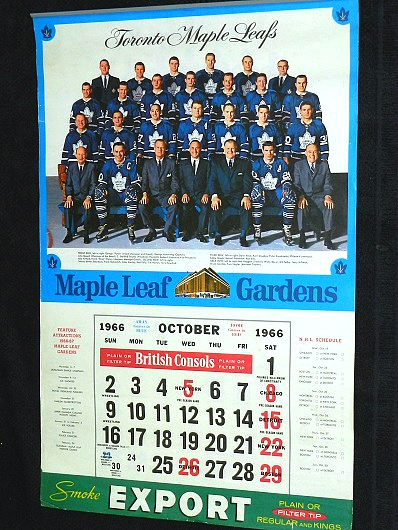

The front (top–left) and second page of the 1966–67 calendar, as the aging Leafs began their march toward a surprise Stanley Cup. The 1965–66 champion Montreal Canadiens graced the top of the November page. Each month in the calendar (below) featured Leafs home games (in red numbers) and away games (in blue). Other events at the Gardens were listed, including home games of the Junior ‘A’ Toronto Marlboros and Sunday–night wrestling shows. The first National Hockey League game I attended was Dec. 3, 1966, as the Leafs upended Detroit, 5–2. Red Kelly, Jim Pappin, Dave Keon, Bob Pulford and George Armstrong scored for Toronto; Ted Hampson and Ray Cullen for the Red Wings (Gordie Howe assisted on Hampson’s second–period goal). Detroit outshot the Leafs, 37–35. Hank Bassen took the loss in goal; Terry Sawchuk the win for the home side. My first live hockey fight featured Brian Conacher of Toronto and Gary Bergman of Detroit, with 1:29 left in the game. The referee was Vern Buffey; the linesmen, Matt Pavelich and Pat Shetler.
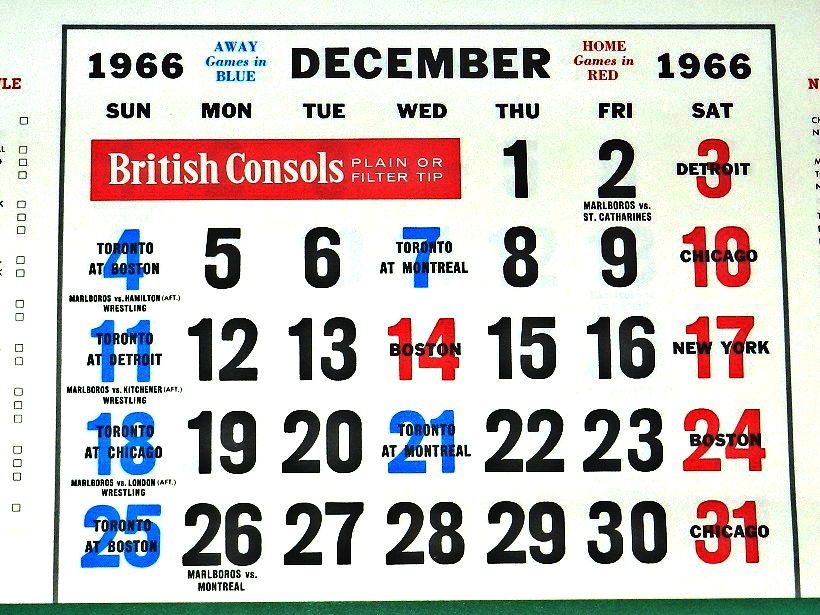
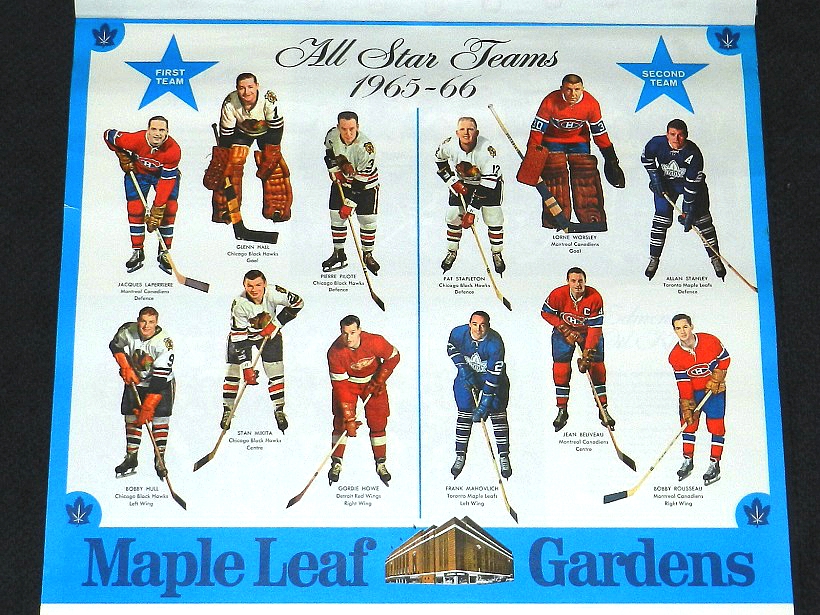
The First and Second NHL All–Star teams from 1965–66. The First team (at left) had Glenn Hall (Chicago) in goal; Jacques Laperriere (Montreal) and Pierre Pilote (Chicago) on defense; Bobby Hull (Chicago) on left–wing; Stan Mikita (Chicago) at center and Gordie Howe (Detroit) on right–wing. The Second team had Lorne (Gump) Worsley (Montreal) in goal; Pat Stapleton (Chicago) and Allan Stanley (Toronto) on defense; Frank Mahovlich (Toronto) on left–wing; Jean Beliveau (Montreal) at center and Bobby Rousseau (Montreal) on right–wing. The Canadiens knocked off the Red Wings in six games to win the 1966 Stanley Cup.
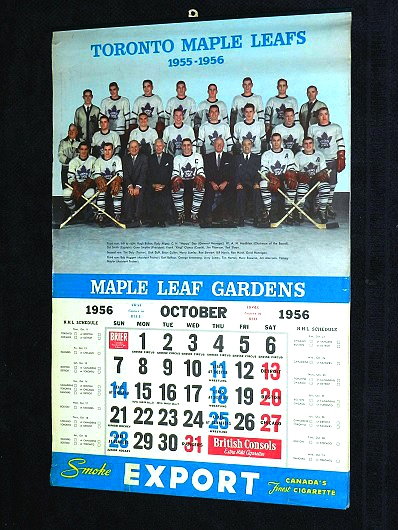
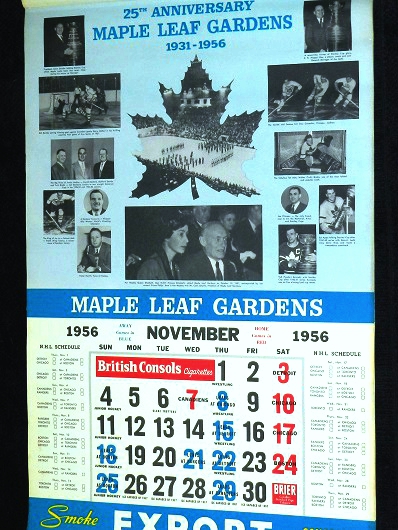
The oldest calendar in my collection (above), from 63 years ago. And, the newest (below), from 46 seasons back. The 1956–57 Maple Leafs, commemorating the silver anniversary of the Gardens (top–right), were the second–worst in franchise history, to that juncture, in a minimum 70–game schedule. Under coach Howie Meeker, the club finished fifth in the six–team NHL with a 21–34–15 record for 57 points (the following year, under Billy Reay, was rock–bottom, as the Leafs finished last with 53 points). George Armstrong led the ’56–57 team in scoring with 44 points in 54 games. Dick Duff led the club with 26 goals. The 1974–75 calendar (bottom–left) was the final one issued. That Toronto club, too, was a major disappointment after a bounce–back season in ’73–74, with rookies Borje Salming, Ian Turnbull and Lanny McDonald. Expected to continue improving, the Leafs fell by eight points in the standings (78 points) but made the playoffs in the 18–team NHL and shocked the Los Angeles Kings (105 points) in a best–of–three preliminary round — the club’s first post–season triumph since 1967. The Philadelphia Flyers (bottom–right) became, in 1974, the first of the 1967 expansion teams to win the Stanley Cup (over Boston) and repeated (over Buffalo) in ’75.
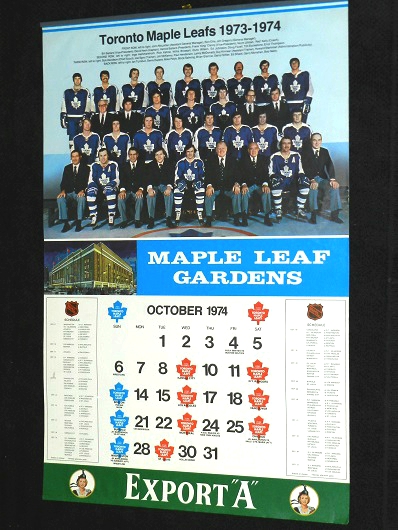
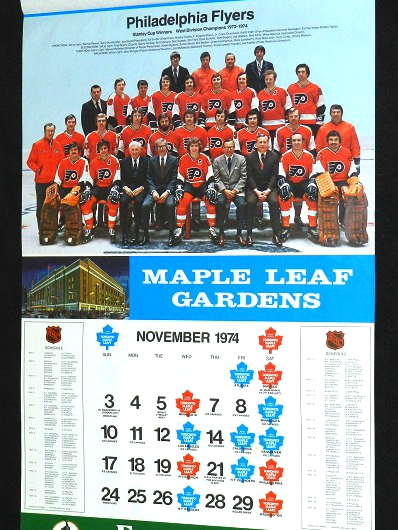

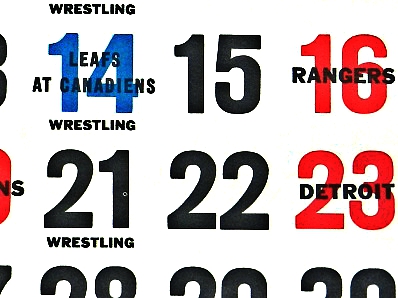
Despite the poor season, the Leafs established a franchise–record for goals in one game, annihilating New York, 14–1, at the Gardens on Mar. 16, 1957 (top–right) — a Saturday. Still in the one–goalie era, poor Gump Worsley had to endure the entire night between the pipes for the Rangers, stopping 33 of 47 shots. Ed Chadwick enjoyed the match at the opposite end for Toronto. The Leafs scored twice in the first period; six times in the second and six more in the third. Brian Cullen and Sid Smith each recorded hattricks. Todd Sloan and Ron Stewart scored twice each with singles going to George Armstrong, Al MacNeil, Rudy Migay and Dick Duff. Ron Murphy scored New York’s only goal at 8:37 of the third period, after the Leafs had built a 10–0 lead. The referee was Red Storey. George Hayes and Bill Morrison were the linesmen.
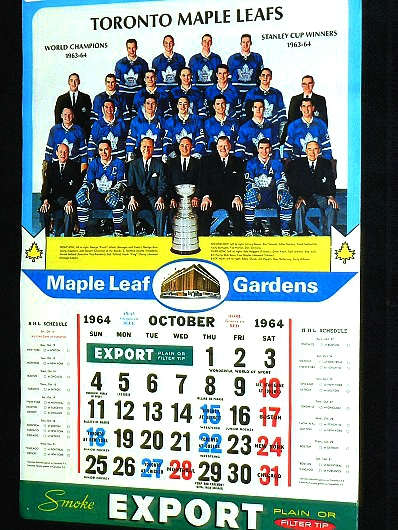
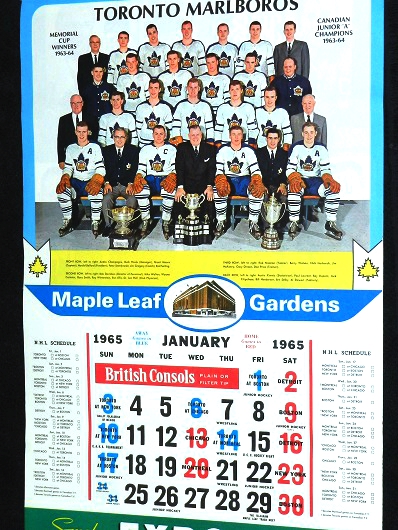
The Maple Leafs began the 1964–65 season (top–left) having won three consecutive Stanley Cups under Punch Imlach. The spring of ’64 was a double–celebration at the Gardens as the Junior ‘A’ Toronto Marlboros (top–right) won the Memorial Cup, sweeping the Edmonton Oil Kings in four games (more below).
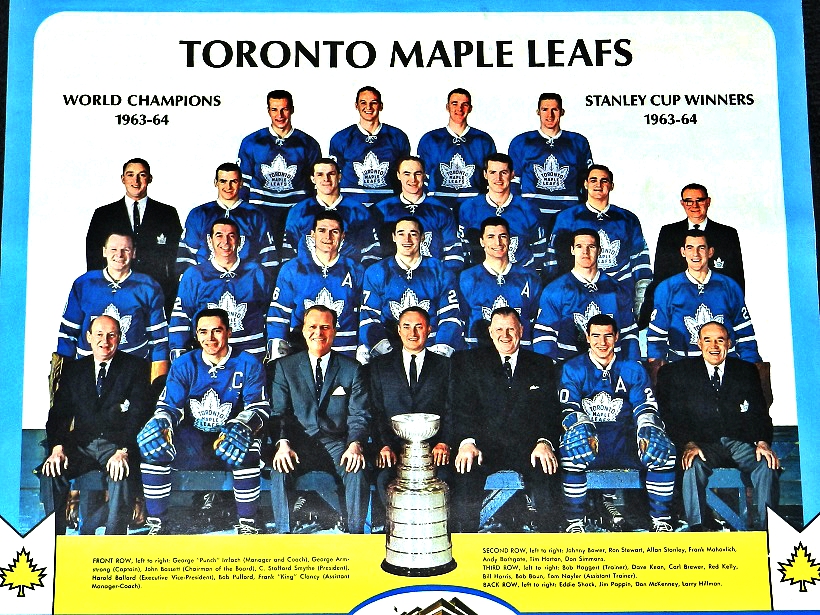
The 1964 NHL champions (above). Toronto rebounded from a 3–2 series deficit against Detroit in the final — avoiding elimination at the Olympia in Game 6 on Bob Baun’s legendary overtime goal while playing with a fractured foot; then blanking the Red Wings, 4–0, at the Gardens in the deciding match. Johnny Bower (51 games) and Don Simmons (21 games) were the Maple Leaf goalies that season. Andy Bathgate (third–from–right, second row) came over from New York in a multi–player trade and had nine points (five goals) in 14 playoff games. Jim Pappin (second–from–left, top row) was a rookie with the Leafs.
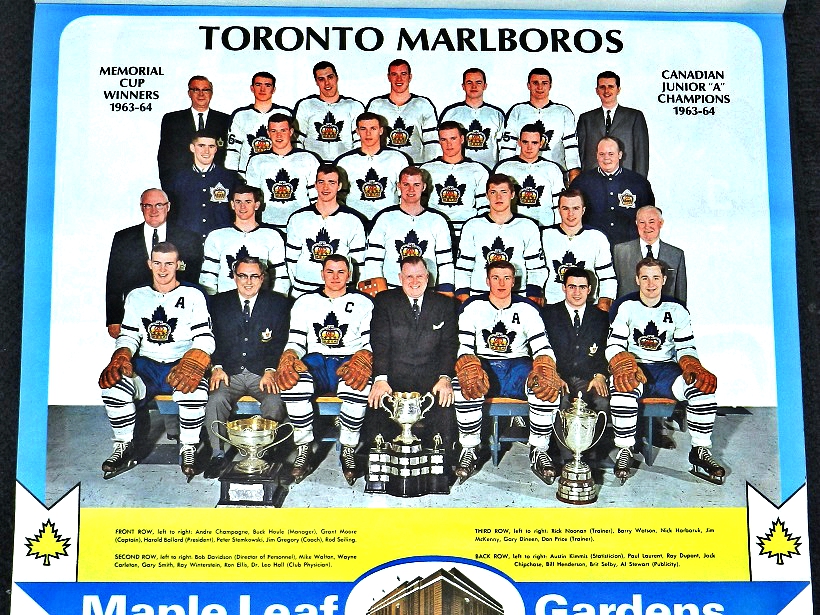
The 1964 Junior ‘A’ champions (above). Coached by Jim Gregory (second–from–right, front row), the Toronto Marlboros featured a bevy of future NHL’ers, including Peter Stemkowski, Rod Seiling, Mike Walton, Wayne Carleton, Gary Smith, Ron Ellis, Nick Harbaruk, Jim McKenny and Brit Selby.
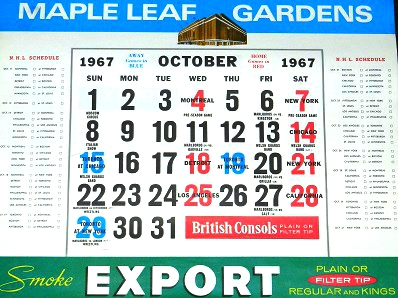

October 1967 was the first month of the expanded NHL, as the league doubled to 12 teams by adding the California Seals, Los Angeles Kings, Minnesota North Stars, Philadelphia Flyers, Pittsburgh Penguins and St. Louis Blues. Los Angeles (Oct. 25) and California (Oct. 28) made the first two appearances at the Gardens (top–right) — the Leafs prevailing, 4–2 and 5–2. Among the All–Stars from 1966–67 was the Second team defense–pairing, bottom–right, of rookie Bobby Orr (Boston) and veteran Tim Horton (Toronto).

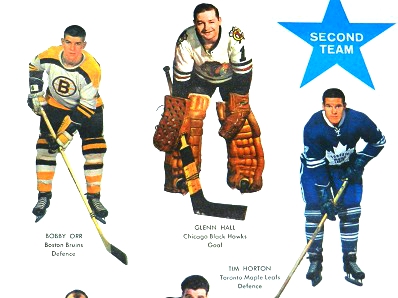
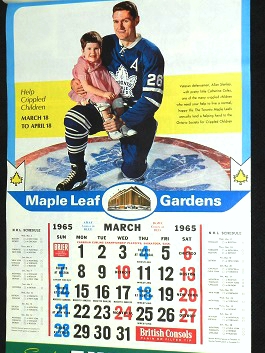
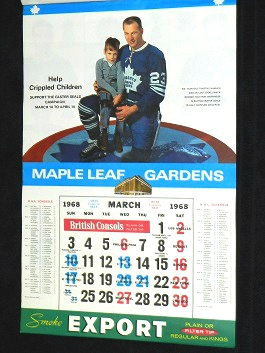
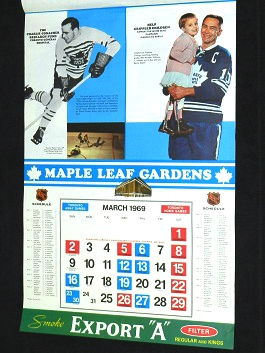
The Maple Leafs’ involvement with Easter Seals occupied a page in the Gardens calendar. Left–to–right (above): Allan Stanley in March 1965; Eddie Shack in March 1968 (even if Shack was playing for Boston at the time); Charlie Conacher and George Armstrong in March 1969.
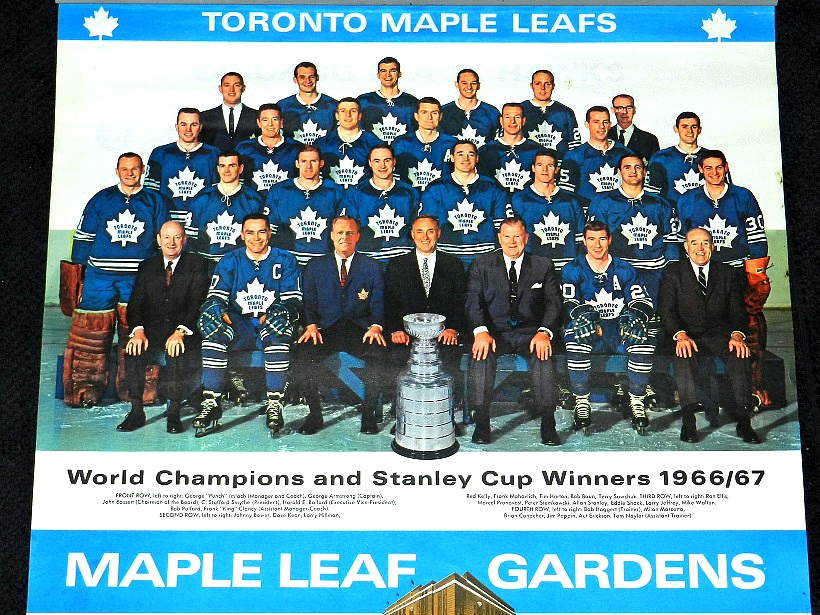
The spring of 1967 featured another double–celebration at the Gardens as the Leafs and Marlboros prevailed for the second time in four years. This, of course, was the last Toronto team to win the Stanley Cup, with goalies Johnny Bower and Terry Sawchuk (above) performing superbly in playoff upsets of Chicago and Montreal. Sawchuk (Los Angeles) and defenseman Bob Baun (California) would be lost to the club in the 1967 expansion draft. George Armstrong was captain; Bob Pulford and Allan Stanley were alternates.
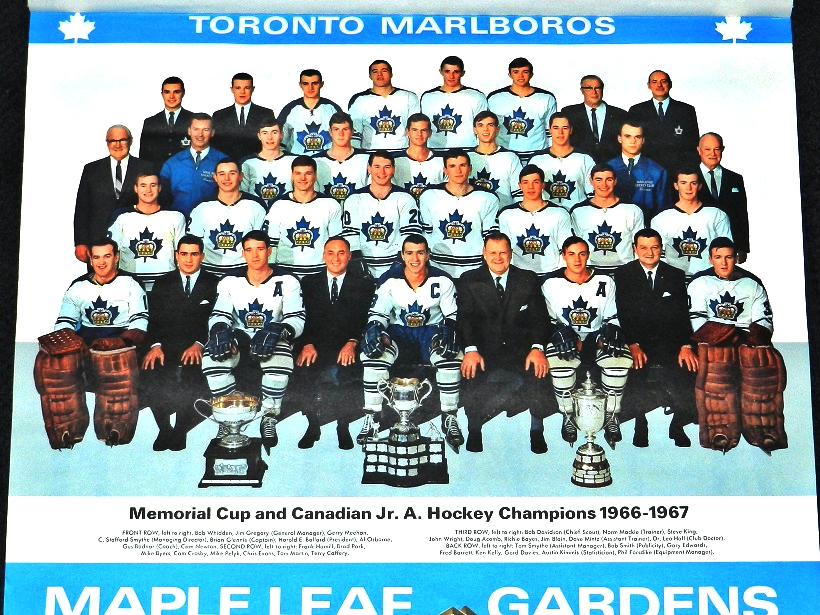
Future Leafs defenseman Brian Glennie captained the 1967 Toronto Marlboros (above), managed by Jim Gregory (second–from–left, front row) and coached by Gus Bodnar (second–from–right). The Marlies defeated the Port Arthur Marrs 4–1 in games to win the Memorial Cup, played at the Fort William Gardens in what is now Thunder Bay. Among those graduating to the NHL from this club were Glennie, Gerry Meehan, Cam Newton, Brad Park, Mike Byers, Mike Pelyk, Gary Edwards and Fred Barrett.
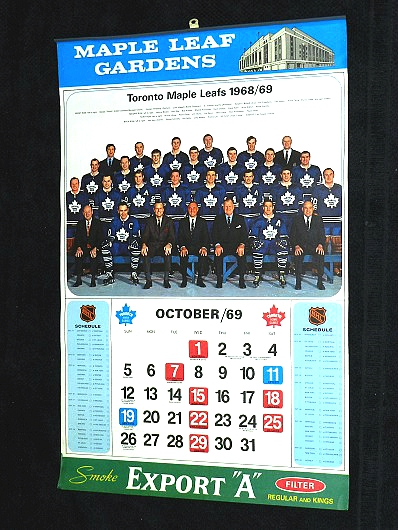
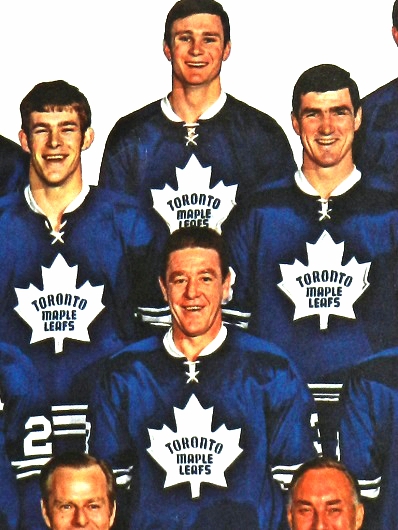
After missing the playoffs with a soft, passive team, the Leafs of 1968–69 bulked up with a trio of rugged defensemen — all rookies: Jim Dorey, Rick Ley and Pat Quinn. Dorey (far–left) and future Leafs GM/coach Quinn (far–right) were in the team photo (above) on the front of the 1969–70 calendar. The ’69–70 Leafs featured rookies at GM (Jim Gregory) and coach (John McLellan), after Punch Imlach was fired in April 1969.
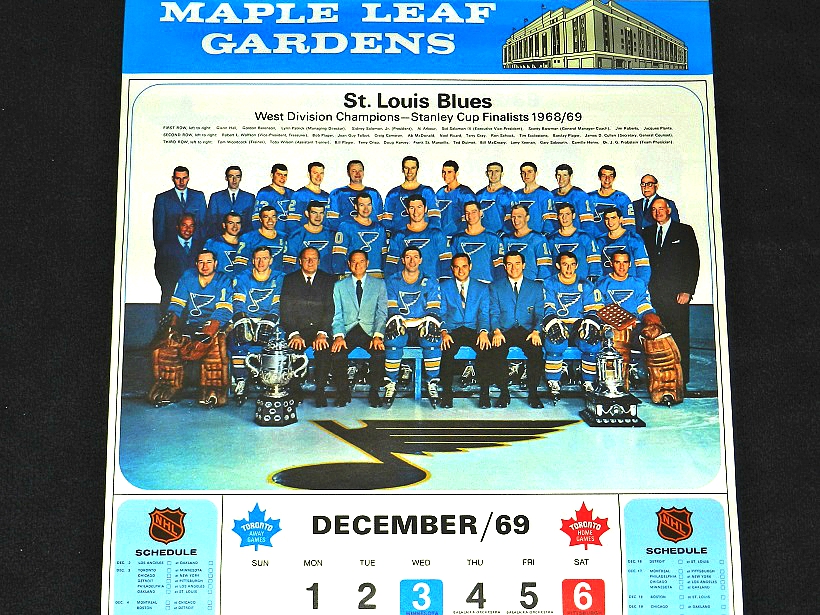
In the first three years of expansion (1968–69–70), the St. Louis Blues — coached by Scotty Bowman (third–from–right, front row) — represented the West Division in the Stanley Cup final, getting swept by Montreal, twice, and Boston. In 1968–69 and 1969–70, the Blues featured an all–time goaltending tandem of Glenn Hall (far–left, front row) and Jacques Plante (far–right). Al Arbour captained the Blues. Red Berenson (second–from–left, front row), acquired from New York in a November 1967 trade, was the scoring star.
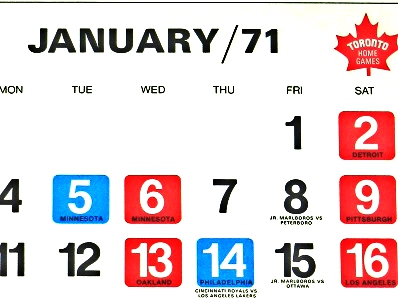
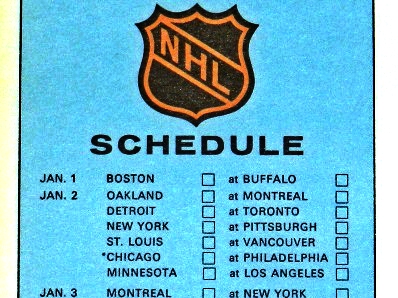
On Jan. 2, 1971, a Saturday night, the Leafs erupted for the second–most goals in franchise history, destroying the Detroit Red Wings, 13–0, at Maple Leaf Gardens (the full NHL schedule flanked the monthly slate of Gardens’ events on each page of the calendar). Toronto scored three goals in the first period; three more in the second, then seven goals in the final frame — the last four coming in a 2:27 span (15:38, 16:48, 17:16 and 18:05). Norm Ullman, rookie Darryl Sittler, Paul Henderson and Billy MacMillan had two goals apiece. Mike Pelyk, Dave Keon, Garry Monahan, Brian Spencer and Jim Harrison added singles. Gordie Howe and ex–Leaf Frank Mahovlich left the visitors’ bench in the third period after exchanging words with coach Ned Harkness. The referee was Bill Friday; the linesmen, Pat Shetler and Willard Norris.
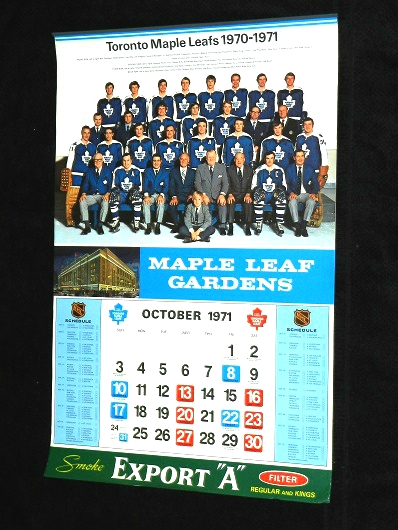
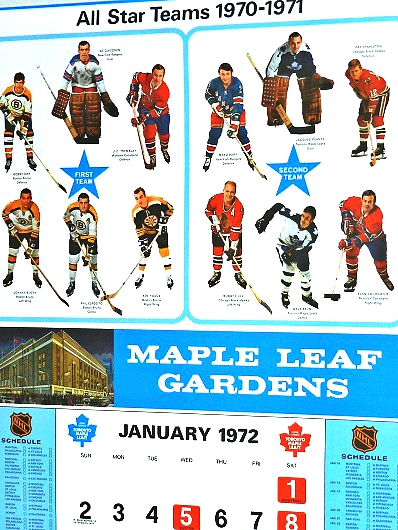
The 1971–72 season (top–left) began for the Leafs in Vancouver and California, but the home opener, against Detroit on Oct. 13, was postponed after president Stafford Smythe died in the morning. It would be played on Nov. 1, 1971, a Monday night. The Leafs of 1970–71 (in team photo) sported newly designed uniforms and a re–shaped logo. The uniforms would prevail through 1991–92; the logo until the 100th anniversary season of 2016–17. The First All–Star team in 1970–71 (top–right) was dominated by Boston players — Bobby Orr on defense; Johnny Bucyk on left–wing; Phil Esposito at center and Ken Hodge on right–wing. The Bruins re–wrote the NHL record book that season with 399 goals (a phenomenal 76 by Esposito), but were upset by Ken Dryden and the eventual–champion Montreal Canadiens in the opening playoff round. Jacques Plante and Dave Keon of the Leafs made the Second All–Star squad.
EMAIL: HOWARDLBERGER@GMAIL.COM

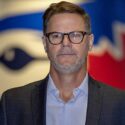
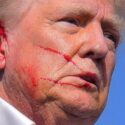
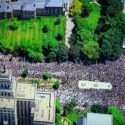

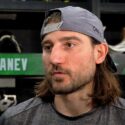
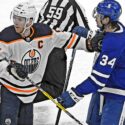
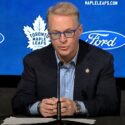
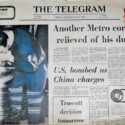
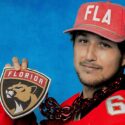
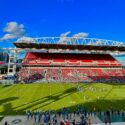
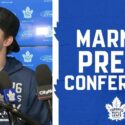

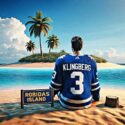

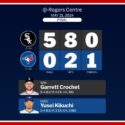
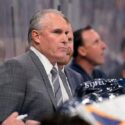
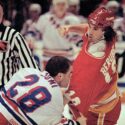
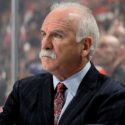

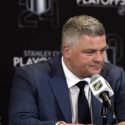
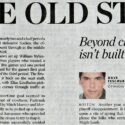
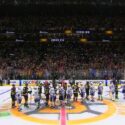
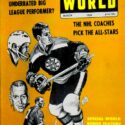
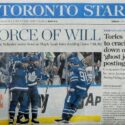

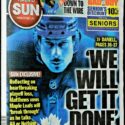
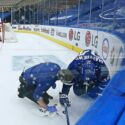
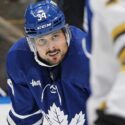
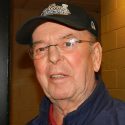
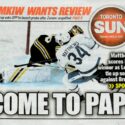
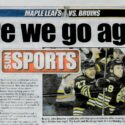
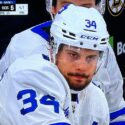
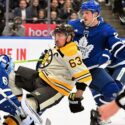
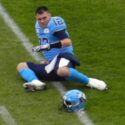
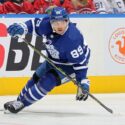
Love the calendars. As a kid I had them hanging in my bedroom for years—even the outdated ones.
One thing I miss from the Gardens days was the shrill school bell that rang at the end of periods—and the siren at the Forum in Montreal. Even that detail had a sense of occasion. The lame horn they use now is the aural equivalent of putting on wet socks.